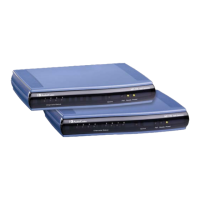SIP User's Manual 172 Document #: LTRT-65412
MP-11x & MP-124
3.4.2.2 Software Upgrade Wizard
The Software Upgrade Wizard allows you to upgrade the device's firmware (cmp file) as
well as load an ini file and/or auxiliary files (e.g., Call Progress Tones). However, it is
mandatory, when using the wizard to first load a cmp file to the device. You can then
choose to also load an ini file and/or auxiliary files, but this cannot be pursued without first
loading a cmp file. For the ini and each auxiliary file type, you can choose to load a new file,
or not load a file but use the existing file (i.e., maintain existing configuration) running on the
device.
The Software Upgrade Wizard allows you to load the following files:
cmp: (Mandatory) compressed firmware file
Optional files:
• ini: configuration file
• Auxiliary files: CPT (Call Progress Tone), PRT (Prerecorded Tones), FXS
Coefficient,and USERINF (User Information)
Warnings:
• To preserve all configuration settings, before upgrading the device to a
new major software version (e.g., from version 5.6 to 5.8), save a copy of
the device's configuration settings (i.e., ini file) to your PC and ensure
that you have all the original auxiliary files (e.g., CPT file) currently used
by the device. After you have upgraded the device, restore your
configuration settings by uploading these files to the device. For saving
and restoring configuration, refer to ''Backing Up and Restoring
Configuration'' on page 175.
• The Software Upgrade Wizard requires the device to be reset at the end
of the process, which may disrupt traffic. To avoid this, disable all traffic
on the device before initiating the wizard by performing a graceful lock
(refer to Saving and Resetting the Device).
Notes:
• Before you can load an ini or any auxiliary file, you must first load a cmp
file.
• When you activate the wizard, the rest of the Web interface is
unavailable. After the files are successfully loaded, access to the full Web
interface is restored.
• You can schedule automatic loading of these files using HTTP/HTTPS,
FTP, or NFS (refer to the Product Reference Manual).

